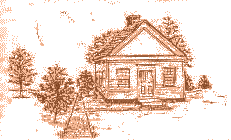LIVING MUSEUM
8 EAST MAIN STREET
 Dating from the early 19th century, this
building was originally Schoolhouse No. 3 in West Avon. When it was threatened
with demolition in 1981 to make room for the town's new library, The Avon
Historical Society, along with concerned citizens and business people, provided
the necessary funds to dismantle and authentically restore the structure on its
present site.
Dating from the early 19th century, this
building was originally Schoolhouse No. 3 in West Avon. When it was threatened
with demolition in 1981 to make room for the town's new library, The Avon
Historical Society, along with concerned citizens and business people, provided
the necessary funds to dismantle and authentically restore the structure on its
present site.
In 1830, Connecticut was still mainly agricultural: towns were rural
communities. They had artisans to allow them to be fairly self-sufficient, but
natural resources were sparse and capital was scarce. Construction of the
Farmington Canal in 1825 and its operation to Northampton, Massachusetts,
influenced the establishment of Avon in 1830. The canal's north-south direction
intersecting with the east-west Albany Turnpike (now Route 44) put Avon at a
commercial crossroad.
During the summer of 1997, a special computer exhibit takes the visitor on a
ride on the Farmington Canal. A virtual tour from New Haven to Northampton gives
the viewer a chance to see how the canal operated and go through all the locks.
Drawings from the 1840's, and photos of the 1930's and 1990's, show the various
stops along the way. Also included in the Museum is a topographical diorama of
the canal through Avon and engineer maps showing the exact specifications of how
it was built in town.
Through a series of artifacts, memorabilia, historic photographs and maps, we
invite you to step back in time and return to Avon, Connecticut, as it was in
1830, the year of its incorporation. We will recreate and examine Avon's history
as part of our local heritage, bridging yesterday to today.
Open Sundays 2 - 4 PM, Free
May through October or by Appointment
Handicapped Accessible
(860) 678-1043
 Back to The Avon Historical
Society, Inc. Main Page
Back to The Avon Historical
Society, Inc. Main Page
 Dating from the early 19th century, this
building was originally Schoolhouse No. 3 in West Avon. When it was threatened
with demolition in 1981 to make room for the town's new library, The Avon
Historical Society, along with concerned citizens and business people, provided
the necessary funds to dismantle and authentically restore the structure on its
present site.
Dating from the early 19th century, this
building was originally Schoolhouse No. 3 in West Avon. When it was threatened
with demolition in 1981 to make room for the town's new library, The Avon
Historical Society, along with concerned citizens and business people, provided
the necessary funds to dismantle and authentically restore the structure on its
present site.